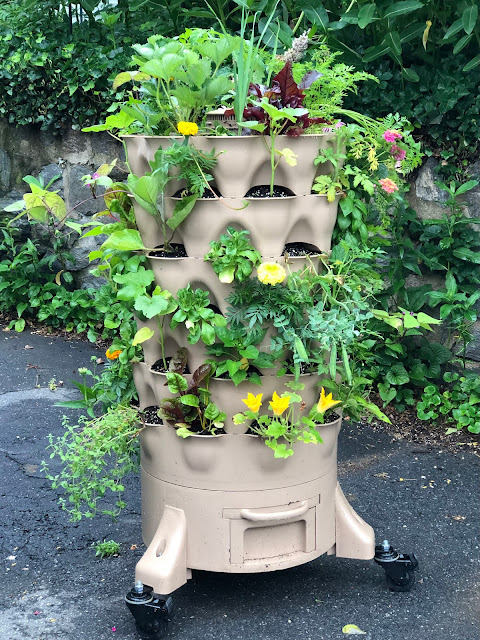Garden Tower Project - The Best Small Space Vertical Growing Container For Home, Patios, Backyards & Driveways - Vegetable Gardening, Urban Homesteading, Self-Reliance, Frugal, Healthy, Minimalist Lifestyle
If you visited us, you'd say we have no land for a vegetable and herb garden. Our tiny city-size lot is little more than six-thousand sq. ft. and upon moving into the 2 bedroom Cape Cod late autumn of 2011 we pulled up the entire yard--lawn, English ivy, a forest of sassafras and myriad other weedy and invasive botanical species and re-landscaped with small bushes, seasonally flowering perennials, grasses, ferns and other ornamentals, trying always to choose climate-friendly and native species. The backyard micro-woods on the highest level of our terraced yard, despite ongoing strategic tree limb pruning, creates so much shade that there's not enough sunlight to intersperse vegetable and herb plantings anymore. The first year or two we lived here it worked. We successfully grew several tomato varieties, rainbow chard and kale, but as the trees mature creating more shade and the husband grows his bonsai hobby utilizing not only our patio space for tiered benches lined with the mini "dancing trees," but he's placed throughout the yard, some on stylish wooden riser platforms, others directly on the ground amidst plantings, the possibilities for vegetable gardening have dwindled to nothing.
I thought I'd cleverly solved my space issue last year when it occurred to me I could garden in our driveway which we don't use for car parking. But using the driveway ended up only solving half of the issue. I shelled out a pocket-full on three pre-made simple wooden trough-style planters, but they took up too much space, looked kind of junky, and I couldn't move them around to catch the sunlight traveling across the driveway or when we have visitors who will park there.
While I was annoyed the whole summer with my failed gardening experiment, I noticed our neighbors across the street in their driveway were successful with theirs. Planted lushly with flowers, they had a vertical pocket growing tower in their driveway and so I decided that next season I'd try one. That's how I learned about Garden Tower Project. I didn't buy the one our neighbors have, but did my own internet window shopping and researching, comparing many different styles and brands until I determined that the Garden Tower Project's version was by far the best designed. I took the plunge and purchased one plus the optional heavy-duty casters kit.
My Spring was busy and I didn't get to assembling the tower until a few weeks ago. It was surprisingly easy, taking not more than a half hour. The only tool needed was a hex wrench with two head sizes.
Planting it was just as simple. The directions are easy to follow even if you don't have a green thumb. And once I'd assembled it and my husband saw how cleverly designed it was he wanted to be involved and started helping with the project. I think it took us about an hour to complete. Since I was late to the season I'd visited a local nursery and purchased a variety of small vegetable and herb plants, a few marigolds and a lantana and several bags of a good pro-mix soil. We planted more than 50 plants, including several varieties of tomatoes, leeks, strawberries, carrots, cucumbers, summer squash, okra, beets, beans, peas, oregano, basil, lettuce, rainbow chard, eggplant and peppers. The first watering took a good 10 to 15 minutes, but subsequent waterings have been much quicker and dependent on the weather. The body above the base turns easily, making it that much easier to water evenly. My husband has fertilized once already with Neptune, his favorite organic brand, and will continue feeding the plants periodically through the season.
Down the center of the planter there is a column for vermicomposting kitchen scraps. I didn't make use of it initially, but last weekend I purchased some live red wigglers and night crawlers and layered in the column compost we'd already made in our yard, alternating it with kitchen scraps and the worms. The growing system is complete and flourishing. I read on the company website that we should empty the compost column every 30 to 40 days. By pulling out the handled tray at the bottom the compost falls into the drawer below it for removal.
Most days, I unlock the casters and roll the planter a few feet one direction or another to maximize sun exposure.
We're both more than pleased with our Garden Tower Project and plan to purchase a second one next Spring. I also plan to sow all the plants from seeds next year.

Comments
Post a Comment